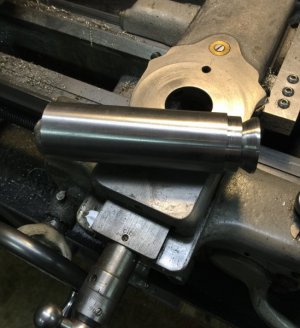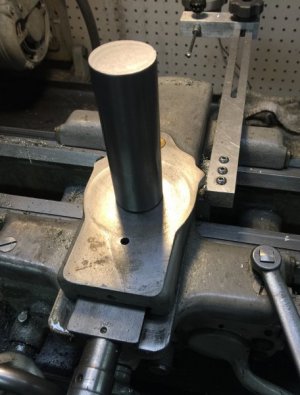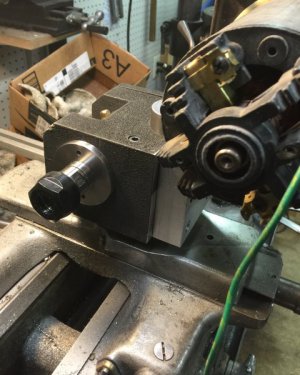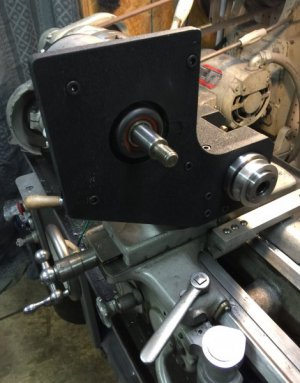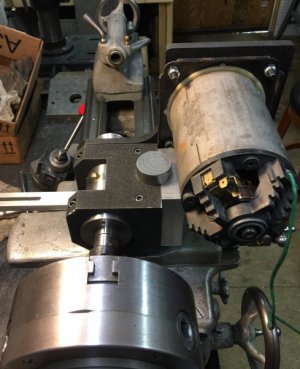Last edited by a moderator:
-
Welcome back Guest! Did you know you can mentor other members here at H-M? If not, please check out our Relaunch of Hobby Machinist Mentoring Program!
You are using an out of date browser. It may not display this or other websites correctly.
You should upgrade or use an alternative browser.
You should upgrade or use an alternative browser.
Building A Tool Post Grinder
- Thread starter Mark_f
- Start date
A
Andre
Forum Guest
Register Today
Been a while since I had it out of its box but I think your correct Mark, it runs CCW. I can't see the direction of part rotation making a lot of difference.
Greg
I'm not positive, but I think it has to do with the grains of abrasive entering and exiting the work instead of surface speed. When parts turn against each other there's a shearing action, and if they rotate together (like gears) the abrasive gets mushed against the work and rubs instead of cuts. If my theory is correct, which I don't know if it is, it would only be true to a minuscule effect because of the vastly different surface speeds between the parts. Again I'm not really sure, just a guess.
A
Andre
Forum Guest
Register Today
Nice work, Mark! Now all it needs is a vertical adjustment screw to help set center height when grinding tapers.
keep watching.........(I mentioned the height adjuster coming in my last post). There will be a height adjuster and a base plate marked in degrees to set the angles.Nice work, Mark! Now all it needs is a vertical adjustment screw to help set center height when grinding tapers.
I got my info from the Dumore instruction manual. I am trying to find another one to see if it says the same thing.I'm not positive, but I think it has to do with the grains of abrasive entering and exiting the work instead of surface speed. When parts turn against each other there's a shearing action, and if they rotate together (like gears) the abrasive gets mushed against the work and rubs instead of cuts. If my theory is correct, which I don't know if it is, it would only be true to a minuscule effect because of the vastly different surface speeds between the parts. Again I'm not really sure, just a guess.
I checked the operator's manual for four different manufacturers and everyone says the grinder and the work must turn opposite directions. BUT, a few people who have used a TPG say it doesn't matter. I guess this will be solved by experimenting. I personally am not fond of running my screw on chuck in reverse. Another thing I find in ALL the manuals is the work speed should be about 50 RPM. This would mean running in back gear? Anyone do this? I doubt running in reverse is a big problem going that slow, BUT....and there isn't a big load on the spindle either.
Another thing I don't understand. The operator manuals all say to set the grinder on an angle, between 10 degrees and 45 degrees, then dress the wheel face while set here. If you dress the wheel flat at the angle, what is the point of setting at an angle? Or am I missing something. I haven't used a TPG but about once in my life about 30 some years ago, So I appreciate any advice from those who have used one a little more.

Another thing I don't understand. The operator manuals all say to set the grinder on an angle, between 10 degrees and 45 degrees, then dress the wheel face while set here. If you dress the wheel flat at the angle, what is the point of setting at an angle? Or am I missing something. I haven't used a TPG but about once in my life about 30 some years ago, So I appreciate any advice from those who have used one a little more.
F
f350ca
Forum Guest
Register Today
I run at a low spindle speed Mark.
Wonder if swinging it to an angle then dressing the wheel gives clearance for the housing and pulley on long shafts.
Greg
Wonder if swinging it to an angle then dressing the wheel gives clearance for the housing and pulley on long shafts.
Greg
- Joined
- Jan 22, 2011
- Messages
- 8,031
OD grinding, wheel and work spin same direction:
http://www.kanabco.com/vms/other_grinding/other_grinding_06.html
Reason given:
"This so that the surface of the grinding wheel and the surface of the workpiece are moving in opposite directions at the point of contact. This also reduces the possibility of ride-up or jamming that can occur if they were rotating in opposite directions."
NEMES (a hobbyist group) published this in 1958:
http://neme-s.org/Model_Engineer_Files/2996-Grinding Rotation & Dressing.pdf
They agree, but give different reasons. Mostly for coolant and grinding sludge control. They also allow for the opposite, and have no serious objections other than making a mess by throwing coolant and grit upward.
https://en.wikipedia.org/wiki/Cylindrical_grinder
Pretty much agrees that the work should run against the wheel in the opposite direction, reason given is smoother work and less chance of jam-up.
I think if I kept looking, I could find more sources that give either answer, and give some of the same, and some different reasons.
http://www.kanabco.com/vms/other_grinding/other_grinding_06.html
Reason given:
"This so that the surface of the grinding wheel and the surface of the workpiece are moving in opposite directions at the point of contact. This also reduces the possibility of ride-up or jamming that can occur if they were rotating in opposite directions."
NEMES (a hobbyist group) published this in 1958:
http://neme-s.org/Model_Engineer_Files/2996-Grinding Rotation & Dressing.pdf
They agree, but give different reasons. Mostly for coolant and grinding sludge control. They also allow for the opposite, and have no serious objections other than making a mess by throwing coolant and grit upward.
https://en.wikipedia.org/wiki/Cylindrical_grinder
Pretty much agrees that the work should run against the wheel in the opposite direction, reason given is smoother work and less chance of jam-up.
I think if I kept looking, I could find more sources that give either answer, and give some of the same, and some different reasons.
- Joined
- Dec 22, 2015
- Messages
- 404
I know the manual that goes with an Atlas tool post grinder (don't have the grinder, but read about it in the manual I found somewhere) stated that the work surface should turn against the wheel. They recommend turning the lathe spindle in reverse for OD grinding, even though the Atlas uses the same threaded spindle arrangement as your South Bend. I also don't like the idea of spinning a screw-on chuck backwards and have been considering building a toolpost grinder that can have its spindle reversible. I am liking your design very much so far, for all of your projects that I have read through. I am planning (unless you object) to copy or adapt several of your designs for my own use because of how much I like your approach to building tooling.
Looking great so far! Thank you for sharing all that you have shared thus far on many projects. I look forward to reading/seeing more of your great craftsmanship!!!
Looking great so far! Thank you for sharing all that you have shared thus far on many projects. I look forward to reading/seeing more of your great craftsmanship!!!


